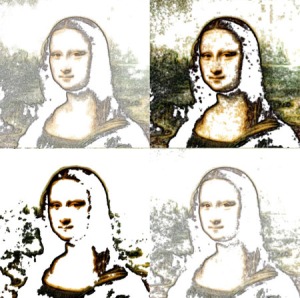These are some of the papers I published last year. Themes: Genetic Algorithms, Sleep Classification, and Self-Organization.
Fernandes, Merelo, Rosa, Investigating Replacement Strategies for the Adaptive Dissortative Mating Genetic Algorithm, in Proceedings of the 2nd Joint Conference on Computational Intelligence, 2010
Abstract:
This paper investigates the effects of modifying the Adaptive Dissortative Mating Genetic Algorithm (ADMGA) replacement strategy on the performance of the algorithm in dynamic problems. ADMGA is a variation of the standard GA with a mating restriction based on the genotypic similarity of the individuals. Dissimilar individuals mate more often than expected by chance and, as a result, genetic diversity throughout the run is maintained at a higher level. ADMGA was previously tested in dynamic optimization problems with promising results: the algorithm shows to outperform standard GAs and state-of-the-art approaches on several problems and dynamics. However, the performance of the algorithm degrades when the frequency of changes increases. Due to the premises under which ADMGA was tested, it has been argued that the replacement strategy that emerges from the algorithm’s dissortative mating strategy may be harming the performance in such situations. This study proposes alternative replacement schemes with the objective of improving ADMGA’s performance on fast changing environments (without damaging the performance on slower ones). The strategies maintain the simplicity of the algorithm, i.e., the parameter set is not increased. The replacement schemes were tested in dynamic environments based on stationary functions with different characteristics, showing to improve standard ADMGA’s performance in fast dynamic problems.
Mora, Fernandes, Herrera, Castillo, Merelo, Rosa, Sleeping with Ants, SVMs, Multilayer Percepetrons and SOMs, ISDA’10, 2010
…and a paper that was presented (not published) at a workshop in PPSN 2010 (held in Krakow), and of which an enhanced version will be present next week in Rome (at LION’11) and published in a LNCS volume.
Fernandes, J.L.J. Laredo, J.J. Merelo and A.C. Rosa, A Self-Organized Criticality Online Adjustment of Genetic Algorithms’ Mutation Rate, Workshop on Self-Tuning, Self-Configuring and Self-Generating Search Heuristics (Self* 2010), 2010
Abstract:
This paper describes an alternative mutation control scheme for Genetic Algorithms (GAs) inspired by the Self-Organized Criticality (SOC) theory. The strategy, which mimics a SOC system known as sand pile, is able to generate mutation rates that, unlike those generated by other methods of adaptive parameter control, oscillate between very low values and cataclysmic mutations. In order to attain the desired behaviour, the sandpile is not just attached to a GA; it is also modified in order for its conduct to reflect the stage of the search, i.e., the fitness distribution of the population. Due to its characteristics, the sandpile mutation arises as a promising candidate for efficient and yet simple and context-independent approach to dynamic optimization. An experimental study confirms this assumption: a GA with sandpile mutation outperforms a recently proposed SOC-based GA for dynamic optimization. Furthermore, the proposed method does not increase traditional GAs’ parameter set.
 Abstract—Ant algorithms are known to return effective results in those problems that may be reduced to finding paths through a graph. However, this class of bio-inspired heuristics have raised the interest of the artistic community as well, namely of the artists that work on the blurred border between art and science. This paper describes an extension of an ant algorithm that, although has been designed as an edge detection tool and a model for collective perception, has also been used for creating artworks that were exhibited to a heterogeneous audience. The algorithm is a self-organized and stigmergic social insects’ model that is able to evolve lines along the contours of an image, in a decentralized and local manner. The result is the emergence of global patterns called pheromone maps. These maps – which were later named with the term pherographia– are grayscale sketches of the original black-and-white image on top of which the model evolves. This work goes beyond grayscale images and addresses colored pherographia, by proposing several image transformation and border selection methods based on behavioral variations of the basic algorithm.
Abstract—Ant algorithms are known to return effective results in those problems that may be reduced to finding paths through a graph. However, this class of bio-inspired heuristics have raised the interest of the artistic community as well, namely of the artists that work on the blurred border between art and science. This paper describes an extension of an ant algorithm that, although has been designed as an edge detection tool and a model for collective perception, has also been used for creating artworks that were exhibited to a heterogeneous audience. The algorithm is a self-organized and stigmergic social insects’ model that is able to evolve lines along the contours of an image, in a decentralized and local manner. The result is the emergence of global patterns called pheromone maps. These maps – which were later named with the term pherographia– are grayscale sketches of the original black-and-white image on top of which the model evolves. This work goes beyond grayscale images and addresses colored pherographia, by proposing several image transformation and border selection methods based on behavioral variations of the basic algorithm.
